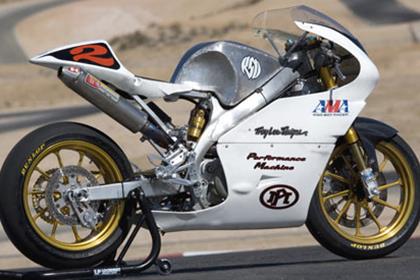Gary Pinchin's singles blog
The Americans are making a big noise about a brand new racing class they have ‘invented’.
It’s called 450 Super Singles and the class has been embraced by the AMA (who run the national superbike series as well as being the governing body of bike sport in the US) and WERA (a club racing organisation).
Proposals are to homologate 2006 or newer machines based 450cc single-cylinder motocrossers and turn them into road race bikes.
Four-stroke single-cylinder road racing is nothing new. In Britain and Europe we’ve had a racing class called Supermono for absolutely ages – stretching back to the 1980s.
And we’ve had bikes with 450cc motocross engines slotted into GP125-type chassis dubbed ‘Minimonos’ running in the Supermono class for about 10 years since Dave Pearce of Tigcraft came up with the idea.
So what’s the fuss now?
An American guy by the name of Gavin Trippe, a consultant to the AMA (the governing body of bike sport in the States), came up with the concept of using motocross-based machines, stock frames as well as engines, to produce a highly competitive racing class which could would offer newcomers a more cost-effective way of going racing.
English-born Gavin Trippe has pedigree as one of motorcycle sport’s great innovators.
Along with another British guy Bruce Cox, and running under the Trippe Cox Productions banner, they promoted the first-ever US motocross GP in 1973, invented Superbikers, a TV-based racing event, which later spawned supermoto, and Trippe was a key figure in the development of AMA Superbike back in 1976.
Gavin Trippe enlisted the help of Roland Sands, a former AMA 250GP National Champion turned custom bike master builder, and Troy Lee of Troy Lee Designs to create and build a concept bike.
Roland Sands tested the bike and the idea was quickly taken up by the US importers of Japanese machines. The resultant publicity has seen Stateside web forums rammed with people excited by the idea.
The Super Singles will utilise a stock motocross chassis, swing-arm, sub-frame and engine from a 450cc class machine but with road racing suspension, aftermarket exhaust system, road race 17” wheels and DoT tyres, single front disc brake, rear-sets and 250-size road racing bodywork.
The propose rules don’t allow any cutting or altering stock frames or engine/gearbox mounts.
Only stock engineers will be permitted and in supermoto form these 450s put out an estimated 62bhp. Slipper clutches will be permitted though.
The Americans reckon a spec fuel will keep costs down (that wasn’t the case when British Superbike ran a spec fuel!). There will also be homologated exhaust pipes and bodywork and a combined rider/bike weight limit rule of 240lbs which they hope will eliminate the need for expensive carbon fibre and exotic metals.
Gavin Trippe is hoping that the wave of interest sweeping the States will spill over into the UK, specifically at British Superbikes as a low-cost supporting class.
He told MCN: “Project 450 is gaining a lot of traction and I am trying to sow the seeds into BSB as a well supported manufacturer-Spec class below 600s. It has a lot of plusses and the reaction is huge here, particularly for guys who want to race, from 15 to 50, who would never start racing on a 600.
“There’s plenty of (options on) equipment and aftermarket, plus we are building spec fairings etc. If the UK & US keep on the same hymn sheet, all the better.”
But British Superbike Race Director Stuart Higgs wasn’t so sure when we put the idea to him of running a Project 450 series as a supporting race to British Superbikes.
He said: “Didn’t singles used to run at WSB races? We had a one-off British Supermono at Snetterton BSB last year and it was a good turn-out but there’s not the kind of space on the BSB programme for yet another class and, even if there was, I’m not sure a single-cylinder race be the right option.”
There was indeed a time when Supermonos ran as a supporting race at World Superbike meetings and enjoyed European Championship status. Now they run at non-championship internationals.
Likewise, Supermono used to share the same billing as British Superbikes but now the British Championship is held at club meetings.
Americans have never previously embraced the class in a big way though there’s been single-cylinder racing with modern bikes at AHRMA events for years – within an organization primarily catering for ‘vintage’ (read classic) machinery.
So why wasn’t single cylinder racing able to sustain the impetus it once clearly had?
Because a) there was never any manufacturer support for the class since no one has been building sportsbike-styled singles for the road and b) the fans didn’t warm to it because it lacked the speed and spectacle of the production-based classes.
Not only that, the class lacked prestige and class. With no factory support it was left to privateer teams, some of them gifted and very innovative engineers.
There were also some very, very good racers at the front end of the field but there wasn’t enough of them so the racing wasn’t always top drawer stuff.
If the manufacturers suddenly started building street bikes, based on the race bikes then that might put a different complexion on things.
They might be more inclined to invest in the long-term prosperity of the class – and what’s more, they push for a pro series in order to maximise the marketing potential of racing.
Where Project 450 misses the point is that it isn’t doesn’t have to be about the four Japanese manufacturers.
Imagine if KTM, Husqvarna, Husaberg, CCM, Benelli and any other European manufacturer you care to name decided to homologate bikes for the series then it could suddenly become a very cool series to watch.
But only if it was a full-on factory war. Still with Project 450 rules but with top flight factory riders – on control tyres too.
Hmmm, might make quite a spectacle.


